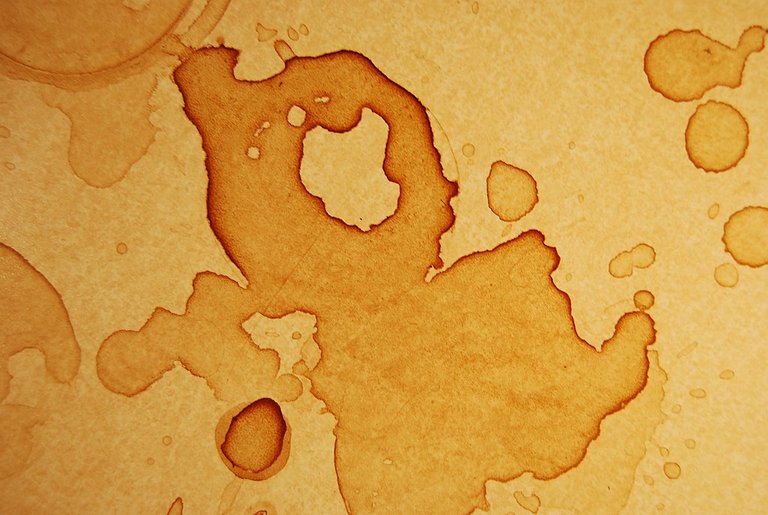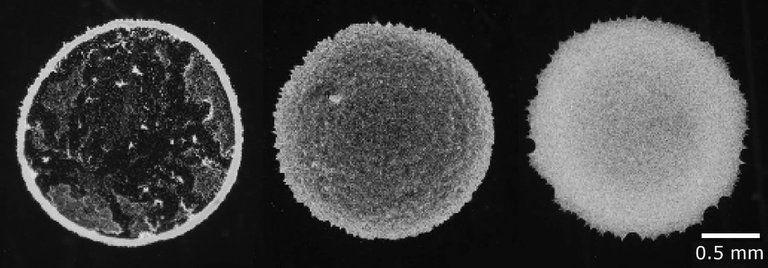New strategy for homogeneous drying of liquids with particles
Do you know what liquids like coffee, wine and ink have in common? The answer is the type of stain they leave behind.

Both wine and coffee are liquids with dispersed particles. Source: edited image, images of the wine glass and coffee cup are in the public domain.
Surely you have noticed that when you spill coffee or red wine on your shirt or tablecloth, it dries in an unusual way, or perhaps it is something that goes unnoticed, since the most undesirable thing is to have spilled coffee or wine, but the fact is that when these liquids dry they leave a characteristic pattern, the stain is lighter in the center and darkens towards the ends, especially around the perimeter, a phenomenon known as "coffee ring".

Example of coffee stains. Source: wikipedia.org.
The coffee ring effect is the pattern left on a surface by a liquid containing particles as it dries, and its name is derived precisely from the darker deposit that forms at the edge of a spilled coffee stain.
Flow mechanism
This phenomenon is really a complex physical process, in which several factors are combined, on the one hand it is due to capillary flow, in addition to multiple interactions between the different interfaces between the liquid, the surface and the dispersed solid. Let's say that when a drop of coffee falls on a surface, the pattern is formed because there is an evaporation preference for the liquid at the edge of the drop, then, the evaporation of this liquid is replenished with the liquid in the center, the liquid flow that occurs from the interior to the edge carries the particles of any dispersed material in the liquid, accumulating it at the edge of the drop and producing this characteristic pattern.
This phenomenon can be very useful for analytical analysis of substances, for example, scientists have proposed to take advantage of this effect to analyze the substances and contaminants present in a drop of tap water in a simple and inexpensive way, analyzing the pattern that leaves the water when drying can be used to identify some components present, such as the content of dissolved solids, alkalinity or metal ions. However, there are applications where this effect is undesirable, such as where uniform drying is required, as in high speed printing techniques such as flexography or inkjet, or in more specific technological applications such as the printing of electronic components on flexible substrates.
New method to suppress this effect and achieve a homogeneous drying pattern
Then, the need to achieve uniform drying patterns in certain applications has driven research on different ways to suppress this effect, some investigations aim at increasing viscosity by adding soluble polymers, also by gelling the liquid, others aim at modifying the substrate, such as making it more porous. In other investigations it has been reported that the control of the flow inside the droplet generates good results in obtaining a uniform film, for example by controlling the Marangoni flows during evaporation to counteract the effect of capillary flow.

The image shows the suppression of the coffee ring (left) of a colloidal polystyrene mixture by adding 0.01% (center) and 0.1% (right) cellulose fibers. Source: Wikimedia.org.
A team of researchers from FAU's Department of Chemical and Biological Engineering recently came up with a strategy that could help achieve uniform drying of particle-containing solutions by modifying the surfaces of the particles with polymer chains so that they effectively repel each other. Their findings have been published in the journal Nature Communications.
They first started by preparing a reference solution consisting of a dispersion of polystyrene particles, this solution shows a marked coffee ring pattern, then they started with model system composed of dispersion of polystyrene particles in a polyvinyl alcohol (PVA) polymer solution, as the addition of PVA increases the viscosity of the system, which induces an improvement in drying uniformity compared to the pure polystyrene solution. However, confocal microscopy images revealed that in this model system the joints still accumulated at the edge, albeit forming a less pronounced pattern than that formed by the pure solution. But to their surprise, by removing the free polymer from the dispersion through repeated spin cycles, with only the polymer molecules physisorbed by the polystyrene particles remaining present, they achieved a completely uniform drying pattern.

Schematic illustration of the process: An aqueous dispersion of polystyrene particles (a) is mixed with an excess polymer solution of polyvinyl alcohol (b). Some of the polymer is adsorbed on the particles (c), washing and centrifugation remove the excess non-adsorbed polymer (d). Source: image elaborated in powerpoint.
Apparently, the free polymer increases too much the surface tension of the droplet, covering the air/water interface, and by removing this free polymer, the dispersed particles are adsorbed at the air/water interface of the droplet, allowing a more efficient and homogeneous drying.
It is important to highlight the importance of developing drying methods for liquids containing dispersed particles, since the idea behind this effect is not to achieve uniform drying of coffee stains, but to make a large amount of pigments suitable for rapid printing applications, and it paves the way for the fabrication of electronic devices on various substrates using the printed electronics method, such as flexible solar cells or biosensors.
Well friends, I hope you liked the information about this method to achieve a homogeneous drying of liquids containing dispersed particles, see you next time!
References
Rey, M., Walter, J., Harrer, J. et al. (2022). Versatile strategy for homogeneous drying patterns of dispersed particles. Nature Communications 13, 2840.
Wikipedia.org. Efecto de anillo de café
Xiaoyan Li (2017). Efecto de anillo de café" ayuda a analizar el agua del grifo. Ciencias aplicadas
Wow! I have never stopped to think about drying patterns in wine and coffee! Thanks for bringing this
!1UP
Hello friend, I think we rarely stop to think about that kind of thing haha, thanks to you for stopping by to read.
You have received a 1UP from @gwajnberg!
@stem-curator, @vyb-curator, @pob-curatorAnd they will bring !PIZZA 🍕
Learn more about our delegation service to earn daily rewards. Join the family on Discord.
Thanks!
PIZZA Holders sent $PIZZA tips in this post's comments:
@curation-cartel(13/20) tipped @emiliomoron (x1)
Learn more at https://hive.pizza.
Watch out for the human traffickers here. You wont know it until its too late. STAY AWAY! Beware, traffickers can be women or men! They will act nice until they dont. There is human trafficking going on around this type of crypto. I have witnessed it. They literally have attempted my murder and are trying to kill me with V2K and RNM. Five years this has been happening to me, it started here, around people that are still here. Homeland security has done nothing at all, they are not here to protect us. Dont we pay them to stop shit like this? The NSA, CIA, FBI, Police and our Government has done nothing. Just like they did with the Havana Syndrome, nothing. Patriot Act my ass. The American government is completely incompetent. The NSA should be taken over by the military and contained Immediately for investigation. I bet we can get to the sources of V2K and RNM then. https://ecency.com/fyrstikken/@fairandbalanced/i-am-the-only-motherfucker-on-the-internet-pointing-to-a-direct-source-for-voice-to-skull-electronic-terrorism ..... https://ecency.com/gangstalking/@acousticpulses/electronic-terrorism-and-gaslighting--if-you-downvote-this-post-you-are-part-of-the-problem if you run into one of them you may want to immediately shoot them in the face. 187, annihilate, asphyxiate, assassinate, behead, bleed, bludgeon, boil, bomb, bone, burn, bury, butcher, cap, casket, choke, chop, club, crucify, crush, curb, decapitate, decimate, deflesh, demolish, destroy, devein, disembowel, dismember, drown, electrocute, eliminate, end, euthanize, eviscerate, execute, explode, exterminate, extinguish, finish, fry, grind, guillotine, gut, hack, hang, hit, ice, implode, incinerate, kill, liquidate, lynch, massacre, maul, microwave, mutilate, neutralize, obliterate, off, pop, poison, punnish, quarter, ruin, shank, shock, shoot, shred, skin, slay, slaughter, smoke, smother, snipe, snuff, squish, stab, strangle, stone, suffocate, suicide, SWAT, swing, terminate, torture, terrorize, whack, waste, wreck. You better fucking kill me.
Thanks for your contribution to the STEMsocial community. Feel free to join us on discord to get to know the rest of us!
Please consider delegating to the @stemsocial account (85% of the curation rewards are returned).
You may also include @stemsocial as a beneficiary of the rewards of this post to get a stronger support.
Thanks for the support!
Thanks for this really cool blog. I learned a few things from it :)
I actually have never paid attention to this. And I can tell you that I have spilled coffee many times (and even wine some times… although this is generally a big waste ;) ).
More seriously, what you wrote in this blog makes total sense, and it is even greater to read that people have thought about the problem of dispersed liquids on more general grounds, in the view of future applications.
Hi friend, I think few people stop to think about how the stains dry haha, but it certainly is amazing to find people working on modifying this effect with possible future applications. Thanks for stopping by to read friend, I'm glad you like the content of my blog, my best regards.
You are welcome! The pleasure was for me :)